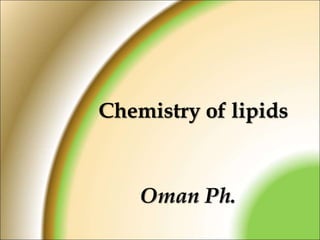
lipd Chemistry1.ppt
- 1. Chemistry of lipids Oman Ph.
- 2. BIOMEDICAL IMPORTANCE The lipids are a heterogeneous group of compounds, including fats, oils, steroids, waxes They have the common property of being: Relatively insoluble in water and Soluble in non-polar solvents such as ether and chloroform.
- 3. Importance : 1. They are important dietary constituents because of: a. Their high energy value b. The fat-soluble vitamins and the essential fatty acids contained in the fat of natural foods .2. Fat is stored in adipose tissue, where it also serves as a thermal insulator in the subcutaneous tissues and around certain organs .3. Non-polar lipids act as electrical insulators, allowing rapid propagation of depolarization waves along myelinated nerves.
- 4. 4.Combinations of lipid and protein (lipoproteins) are important cellular constituent, occurring both in the cell membrane and in the mitochondria, and serving also as the means of Transporting lipids in the blood 5 Knowledge of lipid biochemistry is necessary in understanding many important biomedical areas, eg, obesity, diabetes mellitus, atherosclerosis, and the role of various polyunsaturated fatty acids in nutrition and health.
- 5. LIPIDS ARE CLASSIFIED AS Simple lipids Complex lipids:
- 6. LIPIDS ARE CLASSIFIED AS: SIMPLE OR COMPLEX Simple lipids: Esters of fatty acids with various alcohols. Fats: Esters of fatty acids with glycerol. Oils and Waxes: Complex lipids: Esters of fatty acids containing groups in addition to an alcohol and a fatty acid. I. Phospholipids: Lipids containing, in addition to fatty acids and an alcohol, a phosphoric acid residue. eg, in glycerophospholipids the alcohol is glycerol and in sphingophospholipids the alcohol is sphingosine.
- 7. II. Glycolipids (glycosphingolipids): Lipids containing a fatty acid, sphingosine, and carbohydrate. Other complex lipids: Lipids such as sulfolipids and aminolipids. Lipoproteins may also be placed in this category.
- 8. Fatty acids Fatty acids are building block of most lipids, Having one polar carboxyl group (head) and a non-polar hydrocarbon chain (tail). Fatty acids occur mainly as esters in natural fats and oils but do occur in the un -esterified form as free fatty acids, a transport form found in the plasma. Fatty acids that occur in natural fats has even number of carbon atoms. The chain may be saturated (no double bonds) or unsaturated ( one or more double bonds).
- 9. Thus, Saturated acids end in -anoic, eg, octanoic acid, and Unsaturated acids with double bonds end in -enoic, eg, octadecenoic acid (oleic acid). Carbon atoms are numbered from the carboxyl carbon (carbon No. 1). the terminal methyl carbon is known as the ω or n-carbon.
- 10. Various conventions use Δ for indicating the number and position of the double bonds . e.g. Δ9 indicates a double bond between carbons 9 and 10 of the fatty acid; ω9 indicates a double bond on the ninth carbon counting from the ω- carbon. In animals, additional double bonds are introduced only between the existing double bond (e.g., ω9, ω6, or ω3)
- 11. Unsaturated Fatty Acids Contain One or More Double Bonds Fatty acids may be further subdivided as follows: Monounsaturated containing one double bond. Polyunsaturated containing two or more double bonds. Eicosanoid: (20-carbon) polyenoic fatty acids, comprise the Prostanoids, leukotrienes (LTs), lipoxins (LXs). Prostanoids include prostaglandins (PGs), prostacyclins (PGIs), and thromboxanes (TXs).
- 13. Most Naturally Occurring Have cis Double Bonds. If on the same side of the bond, it is cis-, as in oleic acid if on opposite sides, it is trans-, as in “elaidic acid,” the trans isomer of oleic acid. Geometric isomerism of Δ9, 18:1 fatty acids (oleic and Elaidic acids).
- 14. TRIACYLGLYCEROLS (TRIGLYCERIDES)* ===Are the main storage forms of fatty acids The triacylglycerols are esters of glycerol &fatty acids. Mono- and diacylglycerol wherein one or two fatty acids are esterified with glycerol are also found in the tissues. To number the carbon atoms of glycerol unambiguously, the -sn- (stereochemical numbering) system is used
- 15. Enzymes readily distinguish between them and are nearly always specific for one or the other carbon; e.g., Glycerol is always phosphorylated on sn-3 by Glycerol kinase to give glycerol 3-phosphate and not glycerol-1-phosphate .
- 16. STEROIDS PLAY MANY PHYSIOLOGICALLY IMPORTANT ROLES Cholesterol is probably the best known steroid because of its association with atherosclerosis. However, biochemically it is also of significance because it is the precursor of a large number of equally important steroids that include =Bile acids, =Adrenocortical hormones, =Sex hormones, =D vitamins, cardiac glycosides, sitosterols of the plant kingdom, and some alkaloids.
- 17. All of the steroids have a similar cyclic nucleus resembling phenanthrene (rings A, B, and C) to which a cyclopentane ring (D) is attached. The carbon positions on the steroid nucleus are numbered as shown in Figure
- 18. Cholesterol Is a Significant Constituent of Many Tissues Cholesterol is widely distributed in all cells of the body but particularly in nervous tissue. It is a major constituent of the plasma membrane and of plasma lipoproteins. It is often found as cholesteryl ester, where the hydroxyl group on position 3 is esterified with a long-chain fatty acid. It occurs in animals but not in plants. HO
- 19. For the synthesis of bile salts that are important in lipid digestion and absorption. For the synthesis of steroid hormones that are biologically important like the sex hormones estrogen and progesterone. For the synthesis of vitamin D3 As a structural material in biological membranes. As a component of lipoproteins as transport forms of lipid based energy. Cholesterol is important in many ways: